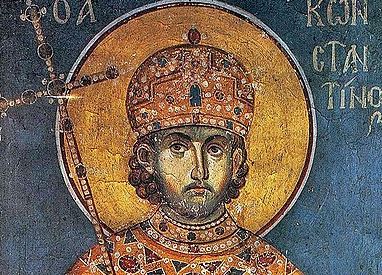The one event in the first 500 years that affected the church more than any other was the friendship with the state that resulted from the conversion of Constantine in 312 and the Edict of Milan in 313. Prior to this time, Constantine had been as steeped in paganism as any other Emperor had been. But as he began to invade Italy, he realized that all the followers of the old gods had ended in failure. Omens were such that the coming battle against his rival was especially to be feared, so, recognizing that “the invader needed divine protection, a god to ‘hold his hand’ above him,” 1 Constantine sought divine favor. According to Eusebius, “Constantius, he knew, had honored the ‘one Supreme God,’ who had given him many ‘manifestations and signs’ of his aid, but he did not know who this god had been. So he prayed to him to reveal himself and ‘stretch forth his hand.’” 2 A vision of a flaming cross in the noonday sky inscribed with the words, “by this, conquer,” and a subsequent dream of Christ bearing the same symbol and commanding him to use this symbol in battle (not to mention his surprising victory) led Constantine to some type of a Christian experience.
Though some believe Constantine was not fully converted (because of a seeming neutrality on religious matters and in public inscriptions), Eusebius testified that Constantine passed sleepless nights studying theology and that “during his own speeches, the Emperor would stand up in reverence whenever he touched on a sacred topic.” 3 Eusebius also claimed that Constantine, who considered himself a “servant of God,” would speak publicly on God’s sole rule in the earth, the necessity of God’s salvation, and the reality and horrors of divine judgment. So great was his Christian conviction that he wrote of his “genuine fear of God’s wrath against his person if he failed to preside over Christian concord in the Church.” 4 Whether or not Constantine’s faith was exclusive may not be certain, but the results of his faith, at whatever level that faith might have been, are certain. His conversion and the Edict of Milan (an edict of toleration) were the prelude to a series of events that would alter the course of Christianity for many centuries.
It marked the merging of the political and religious.
Prior to this period, there was almost no mixing of Christians with the political realm. To be truly Christian was incompatible with involvement in the military or civil affairs. In fact, the entire political regime was antagonistic toward Christianity. But with the conversion of Constantine, Christianity and the Empire became united. The military was coerced into Christianity, even if it was in name only. Constantine’s friendliness toward Christianity caused Christian leaders to increasingly look to the Emperor to intervene in church conflicts, and his army to drive away the “enemy.” Christianity had a growing influence on political matters, and the Empire had a growing influence in church matters. In later centuries when the Empire declined, the Catholic Church took over many functions previously performed by the state, laying the foundation for the current religio-political nature of that church.
It marked the beginning of imperial control over the church.
As stated above, prior to Constantine the church and state were diametrically opposed. Although Constantine himself didn’t dictate doctrine, he called for the councils and his beliefs impacted the general beliefs throughout the Empire. At one point Arianism, though condemned by the Council of Nicaea, almost triumphed because of endorsement by Constantine and his sons. Imperial control over the church gradually increased. Though the church in the West ultimately broke free of imperial rule, the church in the East never did. In succeeding generations the church became dominated by the political state, which it continues to be even to this day.
It marked a change in motives for conversion.
The Christian movement prior to Constantine was characterized by personal evangelism, a sense of urgency, and an insistence on the centrality of one God to the exclusion of all others. Pagans were won over by the content of the message and the proofs of its power as evidenced by miracles. Converting to Christianity would bring them persecution and isolation from society, but the eternal rewards were ample motivation. The expansion of Christianity was contrary to all reason; it was obvious that God was the power behind the movement.
When Constantine became a Christian all this changed. Becoming a Christian was now a smart move socially and politically. Instead of the threat of persecution, there was now the hope of prosperity as Constantine lavished gifts and favors on the Christian community. Bishops no longer had to rely on miracles and the power of God as attestations to their authority — now their authority was acknowledged by emperors. Constantine built grand basilicas for Christian worship (in contrast to the homes, catacombs and humble meeting places they were accustomed to), exempted church lands from taxation, ordered provincial officials to make materials available for construction, set up gifts of food and grain allowances for nuns and widows, and granted exemptions from civil obligations to the clergy. “Overnight, it seemed, he created a Christianity whose bishops and clergy had had their social horizons blown wide open by finding the open-handed Constantine in their midst.” 5 No wonder bribery to become a priest or to be placed on a higher level in the church hierarchy was prevalent!
In 341 one of Constantine’s sons ordered all pagan sacrifices to be abolished in Italy and all pagan temples closed. In some senses, conversion to Christianity was coerced, but it led only to a Christo-paganism. With the politicization of the faith naturally came a laxity in morals, a blending of the pagan and Christian, and a corruption of the clergy.
It marked an advance in the formulation of doctrine.
Before Constantine doctrinal beliefs were simple and faith was deep-seated. The church was unified because of persecution. When Constantine sought to cement together a decaying Empire with the strong Christian institution and faith, unification of doctrine was paramount. This forced Christian leaders to examine the Scriptures and to draw conclusions based on careful study and debate. The period from 325 to 460 has been called the “Golden Age of Scientific Bible Study,” and we owe much to the work that was done during that period. Positively, it gave to the church a unified set of orthodox beliefs and a measure by which to recognize heresy. But, negatively, once these doctrines were formulated, Christian thought in the East became stagnant, since its basic theological views were now cemented. The danger existed (and persisted) that one could be orthodox in doctrine but still fail to live up to the ethical implications of that doctrine. Theology took precedence over ethics.
Conclusion
At first glance, the Christianizing of the Empire appears to have been a victory for Christianity. It marked an end to persecution and accelerated the spread of the faith. But under the surface, we see that it brought compromise, stagnation, indulgence, and a reliance on powers other than God for the preservation of the Church and for guidance into truth. This is an important historical event for Christians in America to remember today. We think we want tolerance or favor from our government, but do we really? America was at one time considered a Christian nation, much the Roman Empire was under Constantine. People became Christians because it was the American thing to do. Christianity and America were almost synonymous. The result was a stagnation of Christianity and compromise. Now we find a generation of “Christians” who espouse immorality and mix it with their own brand of paganism, clergy who are guilty of everything from greed to gross immorality, and a Christian church which is regarded as irrelevant to its culture and is bowing to political pressures. How can these things be?
Christians should look at today’s growing hostility of America toward Christians as a gift from God. True Christianity has always flourished during times of persecution. When Christians finally begin to trust the power of God instead of the power of democracy, when they begin to exemplify radical life change, when they begin to show a combination of “flexibility and uncompromising adherence to… basic convictions,” when they unapologetically set forth the historical claims of Jesus Christ, we will once again see a phenomenal spread of Christianity throughout our country. We must constantly remember that what appears to be defeat by the world’s standards is often victory in the eyes of God, and vice versa. God wasn’t finished with the church at the close of this first period in Christian history, in 500 A.D., and He’s not finished with the church today, either.
Other “Lessons from Church History”: Part 1 — Part 2 — Part 3 — Part 4
[Photo: Retrieved 3/1/18 from Wikipedia; contributor Mark Imanuel Granados; licensed under the Creative Commons Attribution-Share Alike 4.0 International license.]
End Notes
- Earle E Cairns, Christianity Through the Centuries. (Grand Rapids: Zondervan), 1987.
- Ibid., p. 614
- Ibid. p. 628
- Ibid. p. 625
- Ramsay MacMullen, Christianizing the Roman Empire (AD100-400). (New Haven: Yale University Press), 1984.







